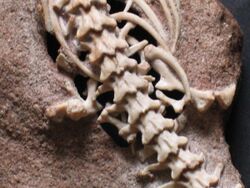Biology:Najash
| Najash | |
|---|---|

| |
| Sacral region of the holotype of the “legged snake” Najash rionegrina | |
| Scientific classification | |
| Domain: | Eukaryota |
| Kingdom: | Animalia |
| Phylum: | Chordata |
| Class: | Reptilia |
| Order: | Squamata |
| Clade: | Ophidia |
| Genus: | †Najash Apesteguía & Zaher, 2006 |
| Type species | |
| Najash rionegrina Apesteguía & Zaher, 2006
| |
Najash is an extinct genus of basal snake from the Late Cretaceous Candeleros Formation of Patagonia.[1] Like a number of other Cretaceous and living snakes it retained hindlimbs, but Najash is unusual in having well-developed legs that extend outside the rib cage, and a pelvis connected to the spine.
Discovery and Description
Fossils of Najash were found in the terrestrial Candeleros Formation, in Rio Negro Province, Argentina , and date to roughly 90 million years ago. The skull and spine of Najash show primitive features that resemble other Cretaceous snakes, such as Dinilysia patagonica and Madtsoiidae.[2] Also, several characteristics of the neck and tail of Najash and Dinilysia patagonica show how the body plan of snakes evolved from a lizard-like ancestor.[3]
Najash had not lost its sacrum, the pelvic bone composed of several fused vertebrae, nor its pelvic girdle, which are absent in modern snakes, and in all other known fossil snakes as well.[4] Nearly all phylogenetic analyses place Najash as an early offshoot of the snake tree, outside of all living snakes.[1][2][3][5]
See also
References
- ↑ 1.0 1.1 Apesteguía, S.; Zaher, H. (2006). "A Cretaceous terrestrial snake with robust hindlimbs and a sacrum". Nature 440 (7087): 1037–1040. doi:10.1038/nature04413. PMID 16625194. Bibcode: 2006Natur.440.1037A.
- ↑ 2.0 2.1 Garberoglio, Fernando F.; Gómez, Raúl O.; Apesteguía, Sebastián; Caldwell, Michael W.; Sánchez, María L.; Veiga, Gonzalo (2019-02-04). "A new specimen with skull and vertebrae of Najash rionegrina (Lepidosauria: Ophidia) from the early Late Cretaceous of Patagonia" (in en). Journal of Systematic Palaeontology 17 (18): 1313–1330. doi:10.1080/14772019.2018.1534288. ISSN 1477-2019.
- ↑ 3.0 3.1 Garberoglio, Fernando F.; Gómez, Raúl O.; Simões, Tiago R.; Caldwell, Michael W.; Apesteguía, Sebastián (2019). "The evolution of the axial skeleton intercentrum system in snakes revealed by new data from the Cretaceous snakes Dinilysia and Najash" (in en). Scientific Reports 9 (1): 1276. doi:10.1038/s41598-018-36979-9. ISSN 2045-2322. PMID 30718525. Bibcode: 2019NatSR...9.1276G.
- ↑ Other known fossil snakes with developed hindlimbs, Haasiophis, Pachyrhachis and Eupodophis—all found in marine environments—all lack a sacral region.
- ↑ Longrich, N. R.; Bhullar, B.-A. S. et al. (2012). "A transitional snake from the Late Cretaceous period of North America". Nature 488 (7410): 205–208. doi:10.1038/nature11227. PMID 22832579. Bibcode: 2012Natur.488..205L. http://opus.bath.ac.uk/37338/3/00_Tetrapodophis_Science.pdf.
External links
Wikidata ☰ Q2720361 entry

